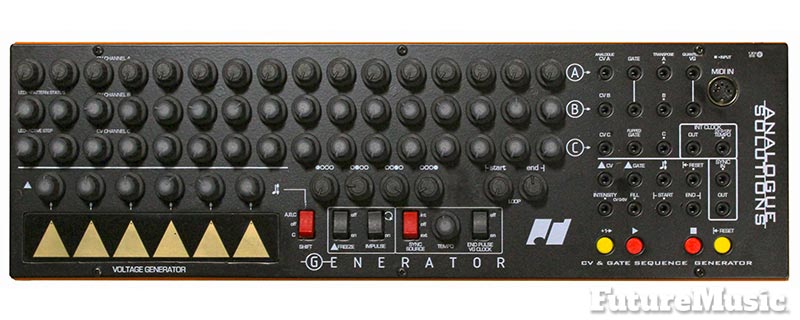Analogue Solutions, the boutique British electronic instruments makers, is readying the second batch of its Generator desktop step-sequencer.

As implied by the CV & GATE SEQUENCE GENERATOR wording, which is boldly blazoned across the well-populated panel, Analogue Solutions’ next- generation Generator features three parallel-running, 16-step CV (control voltage) channels — CV CHANNEL A, CV CHANNEL B, and CV CHANNEL C — and an array of associated hands-on controls housed in a rugged steel and aluminum chassis. Generator is actually a playable step sequencer at its musical heart. Four dedicated knobs offering patent-pending IReTiGaC (Intuitive Real Time Gate Control) can change the rhythm of the beats for the pattern playing by setting which of the 16 steps of the sequence will produce gates; slowly rotating each knob adds more beats in specific positions, thereby increasing the intensity of the rhythm. A pair of associated GATE pattern outputs are available alongside a FLIPPED GATE copy — positive voltage with an inverted state (so the output does the opposite of the main GATE outputs) — for flexibility when connecting to suitably-equipped analog synthesizers, Eurorack modular system setups, or other analogue equipment. These output the rhythm set using those IReTiGaC knobs, and using both together with two different synths creates considerable interplay between them.
The wonderful world of the Voltage Generator is where Generator really steps up to the plate to offer some serious alternative action, though. This is a special kind of transposer/CV generator with six slots — each activated using its own triangular-shaped gold-plated pressure plate. The corresponding knob above each plate is used to set the control voltage output of the Voltage Generator within an approximate range of 0-5V. Those voltage outputs can be sent straight to and mixed with CV CHANNEL A, CV CHANNEL B, and CV CHANNEL C’s respective CV A, CV B, and CV C outputs sockets, with an associated SHIFT switch’s settings determining what goes where: setting said switch into its up position results in the VOLTAGE GENERATOR being mixed with A, B, C (CV CHANNEL A, CV CHANNEL B, and CV CHANNEL C); centre is off, and down results in the VOLTAGE GENERATOR only being mixed with C (CV CHANNEL C). The Voltage Generator’s control voltage is also always available on its own CV output, allowing users to patch it back somewhere else — even externally (to a suitable synth or modular setup).
So what, exactly, can be done with this Voltage Generator?
For starters, it can conceivably be used as a standalone six note interval CV keyboard to directly play an external CV-equipped synthesizer. Patching possibilities abound as the Voltage Generator pressure plates are routed to its own outputs: the CV socket outputs control voltage, so pressing plates harder results in a higher voltage that can, for instance, be used to creatively control clock tempo, intensity, fill, or transpose via their respective INT CLOCK TEMPO, INTENSITY, FILL, and TRANSPOSE sockets. (The INTENSITY input uses a CV of approximately 0-5V to alter the intensity of the rhythm with more beats being added to the rhythm as the voltage increases; the FILL input is similar to INTENSITY, but only affects the last four steps to alter the pattern of notes in the last four beats of the sequencer.) The GATE socket outputs a gate that can be used to clock the sequencer, RESET or START it, for example. Additionally, another output voltage from the VOLTAGE GENERATOR can also be patched to alter internal clock speed or transpose. That said, there are also quantized VG output sockets outputting the same signal which will quantize the Voltage Generator voltage to the nearest semitone (when using 1V/oct synths).
Thereafter, thanks to those three parallel channels of 16 steps, Generator steps back into more familiar step sequencing territory — albeit with dedicated start and end LOOP point controls for initiating interesting patterns — that plays well with any analog gear that has CV and Gate inputs, including vintage or more modern analogue synths and Eurorack modular system setups. Since it does not feature a MIDI output, it is clearly not a MIDI sequencer. Saying that, it is equipped with a MIDI IN socket, so allows sync, start, stop, and resend control signals to be sent from a DAW or MIDI sequencer. Speaking of which, using MIDI Note information, users can program their own clock pattern that can run to clock Generator at the same tempo, half the number of notes to run Generator at half tempo, double the number of notes to run it at double tempo, or even mute the clock note pattern to silence Generator at a particular point before unmuting to get it running again, all the while creating rhythmic patterns to make Generator syncopate with DAW patterns — much more creative and gratifying than simply using MIDI sync alone.
Analogue Solutions’ Generator costs £629 / $749 / €679 and is available now.
Analogue Solutions






